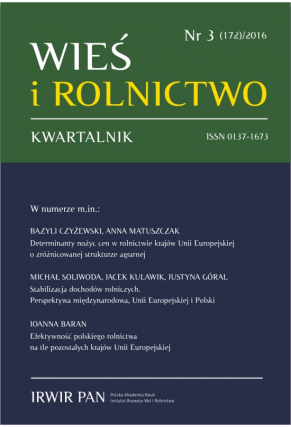Jak reformy WPR przyczyniły się do zmian strukturalnych w rolnictwie?
DOI:
https://doi.org/10.53098/wir032017/02Słowa kluczowe:
WPR, reforma, analiza empirycznaAbstrakt
W niniejszym artykule przedstawiono analizę wpływu wspólnej polityki rolnej (WPR) i jej reform na zmiany strukturalne w rolnictwie w UE-15. Autor bada rozwój tych struktur, posługując się pewną liczbą gospodarstw jako zmienną docelową polityki. Analiza ma na celu zbadanie wpływu polityki rolnej i wprowadzonych reform na rozwój zdefiniowanej zmiennej docelowej, przy uwzględnieniu ogólnego rozwoju strukturalno-ekonomicznego. W badaniu zastosowano ekonometryczną analizę danych panelowych. Z otrzymanych rezultatów wynika, że realizacja różnych inicjatyw w ramach WPR ogólnie zredukowała szybkość zmian strukturalnych i przyczyniła się do przetrwania większej liczby gospodarstw rolnych w sektorze w porównaniu z wariantem zakładającym brak tych inicjatyw. Jednocześnie reformy WPR wprowadzone w latach 1992, 2000 i 2007 doprowadziły do zdynamizowania zmian strukturalnych. Ogólnie rzecz biorąc, różne inicjatywy realizowane w ramach WPR ułatwiły przejście zasobów z sektora rolnego do innych sektorów gospodarki.Bibliografia
Ackrill R., Kay A., Morgan W. (2008). The Common Agricultural Policy and its reform: The problem of reconciling budget and trade concerns. Canadian Journal of Agricultural Economics, 56, 393-411. DOI: https://doi.org/10.1111/j.1744-7976.2008.00137.x
Alston J.M., James J.S. (2002). The incidence of agricultural policy. In: B.L. Gardner, G.C. Rausser (eds), Handbook of Agricultural Economics. Vol. 2b: Agricultural and Food Policy (pp. 1689-1749). Amsterdam-London: North Holland Elsevier. DOI: https://doi.org/10.1016/S1574-0072(02)10020-X
Anderson K., Croser J., Sandri D., Valenzuela E. (2010). Agricultural distortion patterns since the 1950s. What needs explaining? In: K. Anderson (ed.). The Political Economy of Agricultural Price Distortions (pp. 25-77). Cambridge: Cambridge University Press. DOI: https://doi.org/10.1017/CBO9780511778964.004
Anderson K., Nelgen S. (2013). Estimates of Distortions to Agricultural Incentives, 1955-2011 (updated June 2013). World Bank. http://econ.worldbank.org/external/ default/main?pagePK=64214825&piPK=64214943&theSitePK=469382&contentMDK=21960058 [accessed: 23.07.2014].
Arovuori K. (2015). The political effectiveness of agricultural policies – an empirical analysis. Academic Dissertation. PTT Publication 23. 124 p.
Arovuori K., Yrjölä T. (2016). The impact of the CAP and its reforms on the productivity growth in agriculture. In: Proceedings of the 147th EAAE Seminar CAP Impact on Economic Growth and Sustainability of Agricultural Areas. Sofia, 14 p. [also available at: http://ageconsearch.umn.edu/bitstream/212241/2/Arovuori.pdf].
Bates R.H., Block S. (2010). Agricultural trade interventions in Africa. In: K. Anderson (ed.). The Political Economy of Agricultural Price Distortions (pp. 304-331). Cambridge: Cambridge University Press. DOI: https://doi.org/10.1017/CBO9780511778964.014
Beck T., Clarke G., Groff A., Keefer P., Walsh P. (2001). New tools in comparative political economy: The database of political institutions. World Bank Economic Review, 15 (1), 165-176. Updated. DOI: https://doi.org/10.1093/wber/15.1.165
Bullock D.S., Salhofer K. (2003). Judging agricultural policies: A survey. Agricultural Economics, 28, 225-243. DOI: https://doi.org/10.1111/j.1574-0862.2003.tb00140.x
Bullock D.S., Salhofer K., Kola J. (1999). The normative analysis of agricultural policies: A general framework and review. Journal of Agricultural Economics, 50 (3), 512-535. DOI: https://doi.org/10.1111/j.1477-9552.1999.tb00896.x
Dutt P., Mitra D. (2010). Impacts of ideology, inequality, lobbying and public finance. In: K. Anderson (ed.). The Political Economy of Agricultural Price Distortions (pp. 278-303). Cambridge: Cambridge University Press. DOI: https://doi.org/10.1017/CBO9780511778964.013
European Economic Community (1957). The Treaty of Rome. http://ec.europa.eu/economy_finance/emu_history/documents/treaties/rometreaty2.pdf. Referred 29.10.2011. 80 p. [accessed: 23.07.2014].
Eurostat (2016). http://epp.eurostat.ec.europa.eu/cache/ITY_SDDS/en/aact_esms.htm [accessed: 20.10.2016].
FAOSTAT (2016). www.fao.org/faostat/en [accessed: 23.09.2016].
Gawande K., Hoekman B. (2010). Why governments tax or subsidize agricultural trade. In: K. Anderson (ed.). The Political Economy of Agricultural Price Distortions (pp. 241-277). Cambridge: Cambridge University Press. DOI: https://doi.org/10.1017/CBO9780511778964.012
Harvey C.R. (2004). Policy dependency and reform: Economic gains versus political pains. Agricultural Economics, 31, 265-275. DOI: https://doi.org/10.1016/j.agecon.2004.09.012
Hughes-Hallet A.J. (1989). Econometrics and theory of economic policy: The Tinbergen-Theil contributions 40 Years on. Oxford Economic Papers, 41, 189-214. DOI: https://doi.org/10.1093/oxfordjournals.oep.a041892
Jensen M.S., Lind K.M., Zobbe H. (2009). Enlargement of the European Union and agricultural policy reform. European Integration, 31 (3), 329-348. DOI: https://doi.org/10.1080/07036330902782170
Olper A. (1998). Political economy determinants of agricultural protection levels in EU member states: An empirical investigation. European Review of Agricultural Economics, 25, 463-487. DOI: https://doi.org/10.1093/erae/25.4.463
Olper A. (2008). Constraints and causes of the 2003 EU agricultural policy reforms. In: J.F.M. Swinnen (ed.). The Perfect Storm. The Political Economy of the Fischler Reforms of the Common Agricultural Policy (pp. 83-101). Brussels: Center for European Policy Studies.
Olper A., Raimondi V. (2010). Constitutional rules and agricultural policy outcomes. In: K. Anderson (ed.). The Political Economy of Agricultural Price Distortions (pp. 358-391). Cambridge: Cambridge University Press. DOI: https://doi.org/10.1017/CBO9780511778964.016
Pokrivcak J., Crombez C., Swinnen J.F.M. (2006). The status quo bias and reform of the Common Agricultural Policy: Impact of voting rules, the European Commission and external changes. European Review of Agricultural Economics, 33 (4), 562-590. DOI: https://doi.org/10.1093/erae/jbl027
Swinnen J. (ed.) (2008). The Perfect Storm. The Political Economy of the Fischler Reforms of the Common Agricultural Policy. Brussels: Center for European Policy Studies.
Thies C.G., Porsche S. (2007). The political economy of agricultural protection. The Journal of Politics, 69, 116-127. DOI: https://doi.org/10.1111/j.1468-2508.2007.00498.x
Tinbergen J. (1952). On the Theory of Economic Policy. Amsterdam: North-Holland.
Tinbergen J. (1967). Economic Policy: Principles and Design. 4th revised printing. Chicago: Rand McNally.
Wooldridge J. M. (2010). Econometric Analysis of Cross Section and Panel Data. 2nd edition. Cambridge, Mass.: The MIT Press.
World Bank. (2016). http://databank.worldbank.org/ [accessed: 9.11.2016].
Zee F.A. van der (1997). Political Economy Models and Agricultural Policy Formation: Empirical Applicability and Relevance for the CAP. Wageningen: Agricultural University.
Pobrania
Liczba pobrań artykułu
Strony
Jak cytować
Numer
Dział
Licencja
Prawa autorskie (c) 2017 Wieś i Rolnictwo

Utwór dostępny jest na licencji Creative Commons Uznanie autorstwa 4.0 Międzynarodowe.










